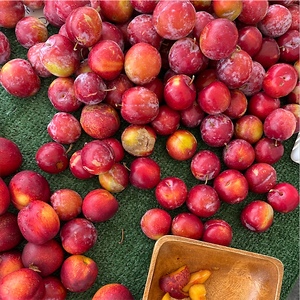


Amber Jewel Plums
Estimated Inventory, lb : 0
Description/Taste
Amber Jewel plums are a small to medium varietal, averaging 5 to 7 centimeters in diameter, and have an oval, conical, to cordate shape with a prominent seam extending the length of the fruit. The plums have thin, smooth, delicate, and taut skin, easily damaged or bruised, showcasing a golden yellow base, covered in crimson, dark red, and orange blush. The plums are also enveloped in variegated yellow mottling and a dull, grey-blue powdery bloom. When the bloom is removed, the surface is glossy and bright. The skin tightly adheres to the golden yellow flesh, and the flesh is dense, firm, semi-fibrous, and aqueous. The flesh is also a semi-freestone variety encasing a small central seed. Amber Jewel plums release a sweet fragrance when ripe and retain a crisp and chewy consistency, giving slightly under gentle pressure. The plums also have a high sugar content, ranging from 18 to 19 Brix, and low acidity, creating a sweet, syrupy, and fruity flavor with subtle, tangy undertones.
Seasons/Availability
Amber Jewel plums are available in the late fall through early spring, cultivated in both hemispheres.
Current Facts
Amber Jewel plums, botanically classified as Prunus salicina, are an Australian variety belonging to the Rosaceae family. The mid to late season plums were developed in the late 20th century and were introduced as a new commercial cultivar for their sweet, fruity flavor and low acidity. Amber Jewel plums are also favored for their storage capabilities and bright, attractive coloring. In the modern-day, Amber Jewel plums are commercially produced for domestic consumption and export. The fruits are a popular plum variety shipped from Australia to Southeast Asia and are sold as a fresh eating plum, savored for its firm texture and juicy nature.
Nutritional Value
Amber Jewel plums are a good source of vitamin A to maintain healthy organ functioning, vitamin E to protect the cells against free radical damage, and vitamin C to strengthen the immune system while reducing inflammation. The fruits also provide calcium to build bones and teeth, vitamin K to promote faster wound healing, fiber to regulate the digestive tract, potassium to balance fluid levels within the body, and other nutrients, including zinc, iron, copper, and magnesium.
Applications
Amber Jewel plums have a sweet, subtly tangy flavor well suited for both sweet and savory dishes. The plums are typically consumed straight, out of hand, and the skin can be kept on for a tangy, sour flavor or removed for a sweeter taste. Amber Jewel plums are can also be chopped and tossed into green salads and fruit bowls, sliced into parfaits, or quartered for appetizer platters. In addition to fresh culinary dishes, Amber Jewel plums can be blended into smoothies for added sweetness or combined into sorbet and ice cream. Amber Jewel plums can also be incorporated into desserts such as cakes, tarts, cobblers, crumbles, and pies, or simmered into compotes, jams, reductions, and sauces to serve with roasted meats. Amber Jewel plums pair well with fruits such as strawberries, blackberries, raspberries, citrus, peaches, and apricots, herbs such as basil, mint, and lavender, fennel, vanilla, chocolate, cheeses such as ricotta and chevre, meats such as lamb, pork, turkey, and poultry, and seafood. Whole, unwashed Amber Jewel plums should be ripened at room temperature. Once ripe, the fruits can be stored in the refrigerator for 2 to 5 weeks, or they can be canned, dried, or frozen for extended use.
Ethnic/Cultural Info
Plums are typically grown in the southern states of Australia and are harvested by hand each season to protect the fruit’s delicate skin. In 2020, Australia produced around 23,347 tonnes of plums, and the fruits are sold domestically in local markets or exported to China and Southeast Asia, where they are valued as a fresh eating fruit. Australia exports around 70% of its agricultural products due to its proximity to Asia and Southeast Asia. The country’s variation in climate also provides quality fruits and vegetables that may not be able to be grown in tropical, humid regions. Amber Jewel plums are a popular variety in Singapore, Malaysia, and Indonesia. In Singapore, the country currently grows only 2% to 3% of its produce and relies on neighboring countries, including Australia, for fresh fruits and vegetables. Australia has developed a reputation with Singaporean markets to offer affordable, quality produce, and supplementary marketing plans, events, and press have been used to further develop a lasting partnership. The Amber Jewel plums featured in the photograph above were sourced from Meidi-Ya Supermarket in the Millennia Walk in Singapore.
Geography/History
Amber Jewel plums are native to Western Australia and were discovered growing as a chance seedling in the garden of Mr. R. A. Yates in 1978. Much of the variety’s history is unknown, but according to some records, Mr. Yates originally named the variety Teak Gold and bred the plums in his orchard in Capel River, Western Australia, from unknown parent varieties. Over time, Teak Gold plums were submitted for a US plant patent in 1996 and approved in 1998 under USPP10277P. The variety was also renamed Amber Jewel for commercial markets. Today Amber Jewel plums are cultivated in Australia, New Zealand, Turkey, and in the United States and are exported worldwide, especially to Southeast Asia. Amber Jewel plums are also sold through online retailers for home garden planting.









